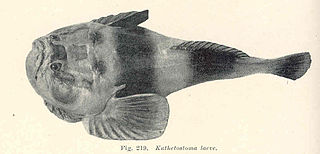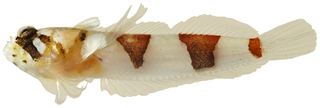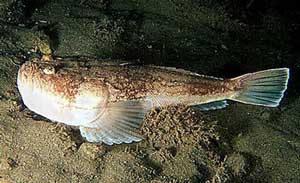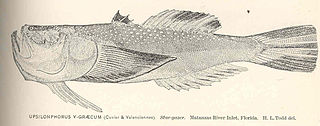Sand stargazers are blennioids; perciform marine fish of the family Dactyloscopidae. Found in temperate to tropical waters of North and South America; some may also inhabit brackish environments. The giant sand stargazer is the largest at 15 cm in length; all other species are under 10 cm.

The stargazers are a family, Uranoscopidae, of perciform fish that have eyes on top of their heads. The family includes about 51 species in eight genera, all marine and found worldwide in shallow and deep saltwaters.
Leptoscopus macropygus, the estuary stargazer, is a species of southern sandfish endemic to the Pacific waters around New Zealand. It occurs at depths between a few and 60 m. This species can reach a length of 17 centimetres (6.7 in) FL. It is currently the only known member of its genus.
Dactyloscopus is a genus of sand stargazers native to the coasts of the Americas.
Dactylagnus is a genus of sand stargazers, found in the eastern central Pacific and western central Atlantic Ocean.
Gillellus is a genus of sand stargazers, found in the eastern central Pacific Ocean and western central Atlantic Ocean.
Heteristius cinctus, the banded stargazer, is a species of sand stargazer native to the Pacific coast of the Americas from Baja California, Mexico to Ecuador where it can be found on sandy bottoms at depths of from 1 to 27 m. It can reach a maximum of 4.5 cm (1.8 in) in total length. This species is currently the only known member of its genus.
Leurochilus acon, the Smoothlip stargazer, is a species of sand stargazer native to the waters around the Caribbean islands of the Bahamas, the Virgin Islands, Antigua and Cuba where it can be found on bottoms consisting of sand, marl and rock at depths from near the surface to 8 metres (26 ft). It can reach a maximum length of 2.9 centimetres (1.1 in) SL. This species is currently the only known member of its genus.

Platygillellus is a genus of sand stargazers native to the Atlantic and Pacific coasts of the Americas.
Sindoscopus australis is a species of sand stargazer native to the Pacific coast of Chile where it can be found in shallow waters with a sandy substrate. It is currently the only known member of its genus. The generic name is a compound noun the first part of which honours Charles E. Dawson's companion in the field and collector of the type, the Chilean zoologist Gumersindo Revuelta and the second part is Latinised Greek skopos, "watcher".
Storrsia olsoni is a species of sand stargazer native to the Atlantic coast of Brazil, being endemic to Atol das Rocas and Fernando to Noronha, where it can be found in tide pools at depths of from 0 to 1 metre. It can reach a maximum length of 3 centimetres (1.2 in) SL. It is currently the only known member of its genus. The binomial name of this species honours the collector of the type, the ornithologist Storrs Olson of the National Museum of Natural History.
Dactyloscopus lacteus, the also known as the milky sand stargazer, is a species of sand stargazer endemic to the Galapagos Islands where it is the only species of Dactyloscopus known to occur there, and is a common fish in its region. It can be found in tide pools and sandy shores at depths of from 2 to 9 metres. It can grow to reach a maximum length of 5 centimetres (2.0 in) SL.
Dactyloscopus metoecus, the Mexican stargazer, is a species of sand stargazer native to the Pacific coast of Mexico where it can be found at depths of from 0 to 7 metres.
Gillellus semicinctus, the half-banded stargazer, is a species of sand stargazer native to the Pacific coast of the Americas from the Gulf of California to Colombia, as well as occurring in the Galapagos Islands. It can be found on sandy substrates at depths of from 5 to 140 metres. It can reach a maximum length of 5.2 centimetres (2.0 in) TL.

Uranoscopus is a genus of stargazer fish from the family Uranoscopidae. The name Uranoscopus is from the Greek, ouranos, "sky" and skopein, "to watch".
Crapatalus is a genus of southern sandfishes native to the coastal waters of Australia and New Zealand.

The southern stargazer is a species of marine fish in the family Uranoscopidae and genus Astroscopus. They are native to the United States.

Astroscopus, the electric stargazers, is a genus of stargazers, a type of percomorph fish from the family Uranoscopidae, part of the order Trachiniformes. The species in this genus are anatomically distinct Uranoscopids, being characterized by internal nares and being the only group of marine bony fish having organs which produce electricity which are derived from the extraocular muscles. They are found on the Atlantic and Pacific coasts of the Americas.

Kathetostoma is a genus of bony fish from the family Uranoscopidae, the stargazers. They are demersal predators which are found in the western Atlantic, Pacific and Indian Oceans, with most species around Australia and New Zealand.
Uranoscopus brunneus, the dark-finned stargazer, is a member of the group Uranoscopidae, the benthic living fishes distributed worldwide in tropical and temperate oceans.





